
Bread is a staple food prepared from a dough of flour and water, usually by baking. Throughout recorded history and around the world, it has been an important part of many cultures' diet. It is one of the oldest human-made foods, having been of significance since the dawn of agriculture, and plays an essential role in both religious rituals and secular culture.

Baking is a method of preparing food that uses dry heat, typically in an oven, but can also be done in hot ashes, or on hot stones. The most common baked item is bread, but many other types of foods can be baked. Heat is gradually transferred "from the surface of cakes, cookies, and pieces of bread to their center. As heat travels through, it transforms batters and doughs into baked goods and more with a firm dry crust and a softer center". Baking can be combined with grilling to produce a hybrid barbecue variant by using both methods simultaneously, or one after the other. Baking is related to barbecuing because the concept of the masonry oven is similar to that of a smoke pit.

Pita or pitta is a family of yeast-leavened round flatbreads baked from wheat flour, common in the Mediterranean, Levant, and neighboring areas. It includes the widely known version with an interior pocket, also known as Arabic bread. In the United Kingdom, Greek bread is used for pocket versions such as the Greek pita, and are used for barbecues as a souvlaki wrap. The Western name pita may sometimes be used to refer to various other types of flatbreads that have different names in their local languages, such as numerous styles of Arab khubz (bread).

A baguette is a long, thin type of bread of French origin that is commonly made from basic lean dough. It is distinguishable by its length and crisp crust.
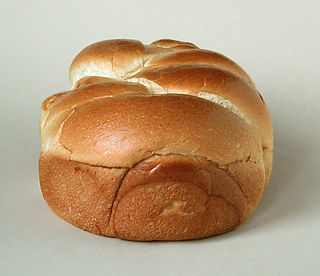
Brioche is a bread of French origin whose high egg and butter content gives it a rich and tender crumb. The chef Joël Robuchon described it as "light and slightly puffy, more or less fine, according to the proportion of butter and eggs". It has a dark, golden, and flaky crust, frequently accentuated by an egg wash applied after proofing.

Meatloaf is a dish of ground meat that has been combined with other ingredients and formed into the shape of a loaf, then baked or smoked. The final shape is either hand-formed on a baking tray, or pan-formed by cooking it in a loaf pan. It is usually made with ground beef, although ground lamb, pork, veal, venison, poultry, and seafood are also used, sometimes in combination. Vegetarian adaptations of meatloaf may use imitation meat or pulses.
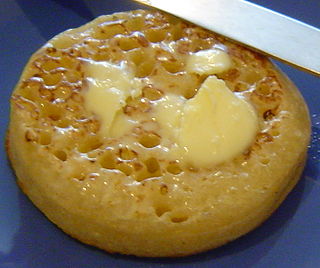
A crumpet is a small griddle bread made from an unsweetened batter of water or milk, flour, and yeast, popular in the United Kingdom, Canada, New Zealand, South Africa and Australia.

Challah is a special bread of Ashkenazi Jewish origin, usually braided and typically eaten on ceremonial occasions such as Shabbat and major Jewish holidays. Ritually acceptable challah is made of dough from which a small portion has been set aside as an offering. Challah may also refer to the dough offering. The word is biblical in origin, meaning "loaf". Similar braided breads such as kalach and vánočka are found across Central and Eastern Europe.

A bread making machine or breadmaker is a home appliance for baking bread. It consists of a bread pan, at the bottom of which are one or more built-in paddles, mounted in the center of a small special-purpose oven. The machine is usually controlled by a built-in computer using settings input via a control panel. Most bread machines have different cycles for different kinds of dough—including white bread, whole grain, European-style, and dough-only. Many also have a timer to allow the bread machine to function without operator input, and some high-end models allow the user to program a custom cycle.

A bread pan, also called a loaf pan, is a kitchen utensil in the form of a container in which bread is baked. Its function is to shape bread while it is rising during baking. The most common shape of the bread pan is the loaf, or narrow rectangle, a convenient form that enables uniform slicing. The bread pan is made from a conductive material such as metal which might be treated with a non-stick coating. It can also be made of heat-resistant glass, ceramic, or a special type of paper that sticks to the dough but is easily removed, once cooked. Bread pans are found in a variety of designs and sizes providing the baker with different possibilities not only for baking bread, but also cakes and puddings.
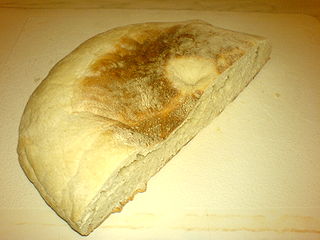
A stottie cake or stotty is a type of bread that originated in North East England. It is a flat and round loaf, usually about 30 centimetres in diameter and 4 centimetres deep, with an indent in the middle produced by the baker. Elsewhere in the world, bread considered similar to the stottie is known as "oven bottom bread", though this term is a relative newcomer, given that, prior to the widespread use of cast iron ovens with shelves, ovens were built of brick and had only the bottom available to bake on. One chief characteristic is the heavy and dough-like texture of the bread. Though leavened, its taste and mouth-feel is heavy and very reminiscent of dough. It is heavy and dense because it has only been allowed to prove once rather than the usual twice. This indicates that its origins lie in the breads used to "test" ovens, and that it may be related to similar breads baked elsewhere in Europe for the same reason. Anecdotal evidence also suggests that some stotties were made with the offcuts of dough when all of the required loaves had been baked.

A hush puppy is a small, savory, deep-fried round ball made from cornmeal-based batter. Hushpuppies are frequently served as a side dish with seafood and other deep-fried foods.
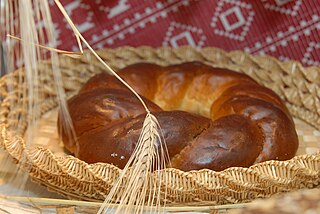
Kolach or kalach is a traditional bread found in Central and Eastern European cuisines, commonly served during various special occasions – particularly wedding celebrations, Christmas, Easter, and Dożynki. The name originates from the Old Slavonic word kolo (коло) meaning "circle" or "wheel". Korovai is sometimes categorised as a type of kolach.
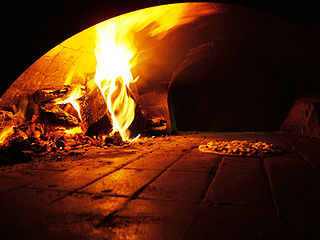
A masonry oven, colloquially known as a brick oven or stone oven, is an oven consisting of a baking chamber made of fireproof brick, concrete, stone, clay, or cob. Though traditionally wood-fired, coal-fired ovens were common in the 19th century, and modern masonry ovens are often fired with natural gas or even electricity. Modern masonry ovens are closely associated with artisan bread and pizza, but in the past they were used for any cooking task involving baking. Masonry ovens are built by masons.

Johnnycake, also known as journey cake, johnny bread, hoecake, shawnee cake or spider cornbread, is a cornmeal flatbread, a type of batter bread. An early American staple food, it is prepared on the Atlantic coast from Newfoundland to Jamaica. The food originates from the indigenous people of North America. It is still eaten in the Bahamas, Belize, Bermuda, Canada, Colombia, Curaçao, Dominican Republic, Jamaica, Puerto Rico, Saint Croix, and the United States.
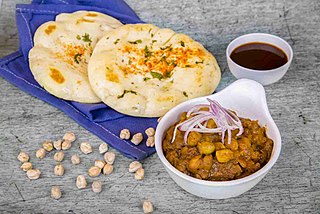
Kulcha is a Persian term for a disc-shaped loaf of leavened bread. In India, this term is commonly used for regular English bread.

Pone is a type of baked or fried bread in American cuisine, and the Cuisine of the Southern United States. Pone could be made with corn, or some other main ingredient could be used like sweet potato. This style of bread, eaten cold as a breakfast food, was a staple food of the cuisine of the Thirteen Colonies.

















